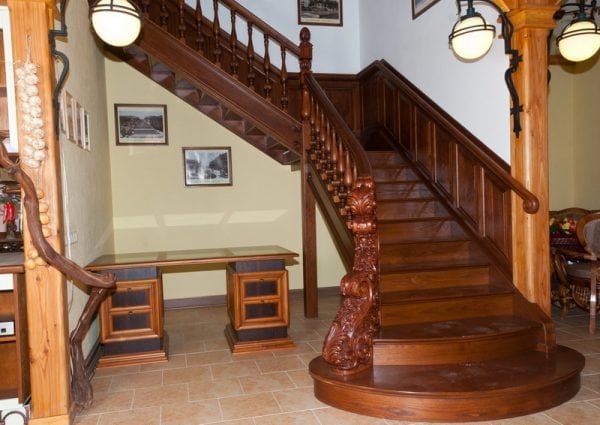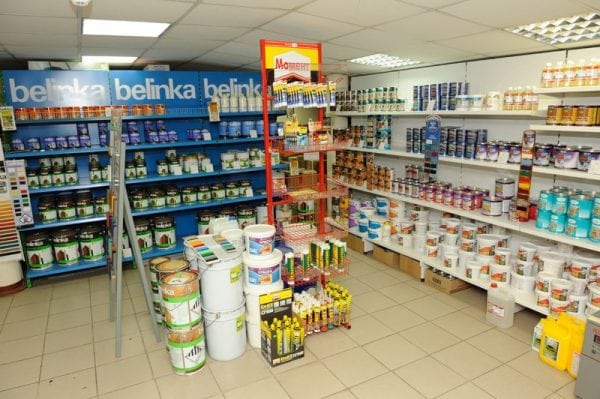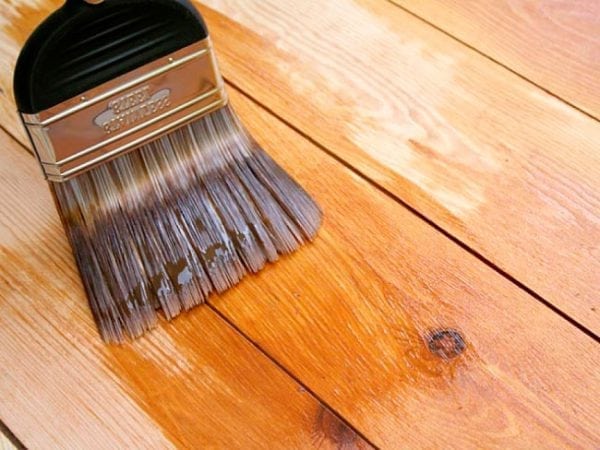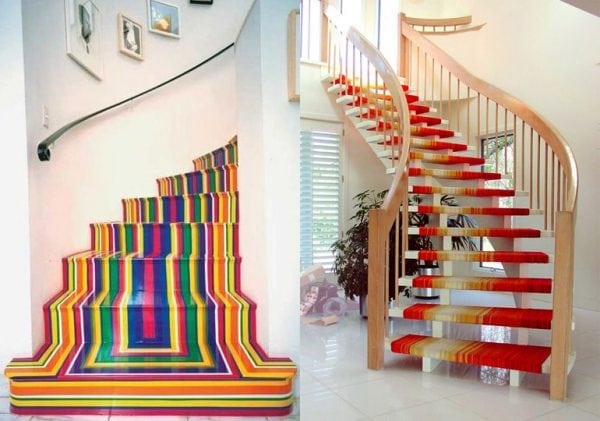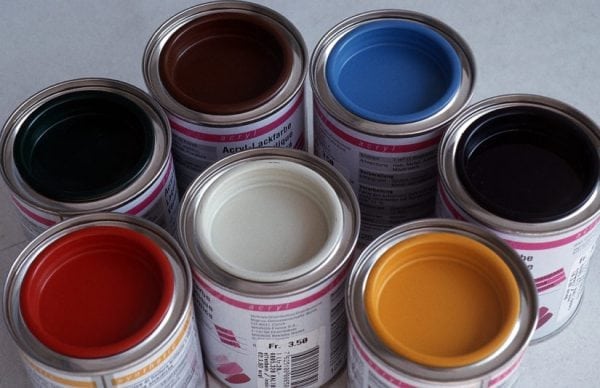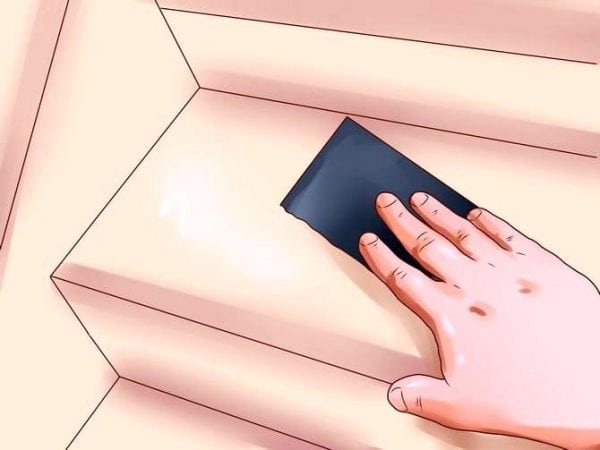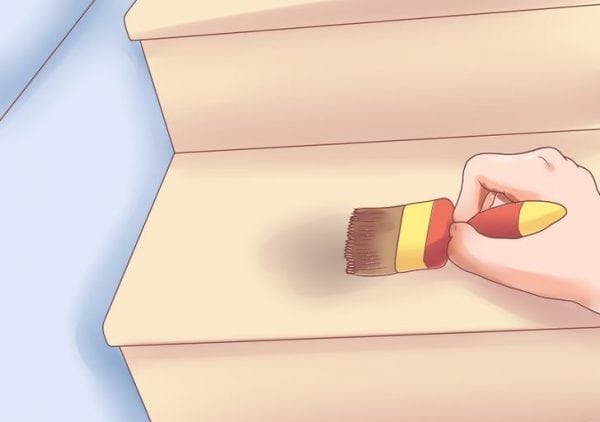The staircase in the house is an important part, especially if the building consists of several levels. With it, you can not only climb to the next floor. It should become a unique element of the interior. Therefore, to know how and how to paint the stairs, it is necessary for each owner of a two- or three-story private house.
- Varieties of paintwork
- Stain
- Clear / tinted wood varnish
- Paints for wood
- Ladder paste
- What to look for
- Staining technology
- Foundation preparation
- Paint coating
- Varnishing
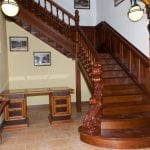
Varieties of paintwork
To give the staircase a finished look, several varieties of paints are used. These are varnishes, impregnations and actually paints. The former emphasize the structure of the tree (tinted) or fix the result (transparent), the latter also emphasize the beauty of the wood pattern, but need additional fixing clear varnish. Paints allow you to paint the stairs as you like.
Staining is done not only for aesthetic purposes. On a floor the grooved board from a pine is most often used. Despite its strength, an unopened tree wears out 5 times faster. This is due to the fact that dust and grains of sand are clogged in the pores, which eventually destroy the structure of the floorboards. Opening a staircase made of pine or any other tree with varnish or paint with your own hands, you extend its service life.
Stain
Stain is one of the cheapest compounds for covering stairs. Impregnation is of different colors. It is designed to protect wood and give it a certain shade. But it is better not to cover the stairs only with a stain - after drying, use varnish.
to contents ↑The primer is usually used before applying varnish or paint, as it improves adhesion to the wood and makes the wood structure more uniform. If the primer is slightly tinted, then you can emphasize the characteristic woody pattern. The primer also contains substances that prevent the tree from rotting.
Clear / tinted wood varnish
Lacquer covers the steps, balusters and railings. The colorless composition does not hide the texture of the tree. It is very important that the grinding of all elements of the staircase is performed at the highest level. Transparent varnishes come in several forms:
- Latex. Non-toxic, safe for humans and animals. When applied to wood, it forms a thin, durable, water-resistant layer. It has the properties of an antiseptic - protects the tree from mold, rot. It is used both indoors and outdoors.
- Water based or acrylate. It does not have an unpleasant odor, is non-toxic, forms a sufficiently durable coating, resistant to mechanical damage, prevents the aging of wood.
- On synthetic resins. Such varnishes dry quickly, are resistant to aggressive environments (alkalis, acids), are used only for internal work. Do not use varnishes on synthetic resins for painting steps. For balusters and railings, they are suitable.
- The yacht. There are different types, depending on the base - alkyd and its varieties (urethane-alkyd, alkyd-urethane) and acrylate. It is toxic, therefore, applying it inside the living room, put on a respirator, otherwise the probability of poisoning is 99%.
Advice! Use yacht clearcoat for painting stairs only as a last resort. It is poisonous even after drying.
Tinting varnishes include oil formulations. With their help, you can change the color of the tree from pale yellow to rich brown. When choosing, you need to see how many percent of the oil is included. To color the stairs, this parameter should be at least 65%. In this case, you get a durable, wear-resistant coating. If there is only 50% or less of oil in the oil varnish, there can be no talk of any strength. Such a composition is suitable only for balusters and railings.
Paints for wood
On sale you can find a great many different compositions. But which one is suitable for painting a wooden staircase? To answer this question, you need to consider the varieties of paints used for wood:
- Oil. Consist of drying oil, stabilizers and coloring pigment. They do not have a pungent odor, are affordable, are available in a rich color palette, and are economically consumed. However, a tree under such paint does not breathe. The resulting surface can not withstand mechanical damage, quickly erases and dims. Service life is up to 5 years.
- Alkyd. Based on pentaphthalic varnish with the addition of coloring pigment and antiseptic additives. Dry quickly. The finished coating is flexible and resistant to mechanical damage, durable. Alkyd paints are cheap, have a rich color palette.
- Acrylic Based on acrylic resins. Non-toxic, without a pungent odor, dry quickly, wear-resistant, have a rich color palette, do not fade with time. A tree under such a covering breathes. Service life is up to 20 years.
to contents ↑Advice! Alkyd paints for wood give consistently good results. Choose them if you want to save a little and get high-quality staircase cover.
Ladder paste
Pasta is considered an unconventional type of coating. It consists of linseed oil and beeswax. The consistency of the paste depends on the hardness of the tree. If the tree is solid, then there should be four times more linseed oil than wax. For soft rocks, two parts of the oil are taken per part of the wax. You can cook the pasta yourself or buy in the store.
to contents ↑The surface treatment is quite simple: the paste is simply rubbed in, for this you need to use a natural fabric without lint - this will make the surface of the stairs a bit dull, with a silky sheen.
What to look for
The selection criteria for a certain type of paintwork for a wooden staircase are as follows:
- Floor load. If the stairs to the second / third floor are often used, then a wear-resistant coating is chosen.
- The breed of wood. Pine floors can and should be painted, larch boards have a beautiful pattern, so it is better to choose colorless or tinted varnish.
- The presence of ventilation. The staircase, as a rule, is located not far from the entrance zone, which means that there should not be any problems with airing. Therefore, you can choose any paintwork.
- Cost. The issue of savings is especially important if a lot of money has been spent on repairing or building a house. In this case, it is possible to choose paintwork materials for the stairs cheaper, but not at the expense of the quality of the finished coating.
Staining technology
The painting of a wooden staircase takes place in 2 stages. This is the preparation of the base and, directly, the opening with varnish or paint of the railing, balusters, steps. The first stage is very important, you cannot do without it if you want to get a beautiful and smooth staircase.
Foundation preparation
To work, you need a solution for washings of old paint, wood putty or alternative methods of sealing cracks (wood chips, wood dust mixed with colorless varnish), antiseptic primer, iron brush, putty knife, sandpaper - 80, 100, 120, 180 - 220, 240 - 320 and nulevka.
DIY ground preparation technology is simple:
- Clean the stairs and wash them with water. Then let it dry completely.
- Treat the steps with an old paint remover. Use a spatula to remove the swollen coating. That which did not rise, tear off with an iron brush.
- Strip the steps, balusters and railings with emery cloth, and preferably with two - first the 80th, then the 100th, remove the dust with a brush, vacuum the steps further.
- Close the gaps. Putty will not last long if the staircase is actively used. Try to close the cracks with wood chips. Pick a piece according to the size of the hole, grease it with PVA glue and put it in place. Another way to seal the cracks: mix wood dust with a colorless varnish, seal the cracks with the resulting composition and let dry.
- Walk again with an emery cloth, now 120th, remove the dust and finish the job with zero. Ideally, steps, balusters, and railings should be smooth "like an egg."
- Clean the stairs with an antiseptic primer. Use a roller for this. Make sure that the composition gets into all the recesses and jewelry (if any).
- Wait for the primer to dry.
Now you can proceed to the final stage.
to contents ↑Paint coating
This is a crucial moment. The appearance of the stairs and how harmoniously it fits into the interior of the house depends on the quality of the coating. To work, you need paint and a brush / roller. You can use a spray gun (costs significantly more than the usual tools for applying paintwork).
DIY paint technology:
- Open the jar. Using a long, sturdy wooden stick, mix the paint thoroughly. There should not be any lumps in it.
- If the composition is excessively thick, dilute it with a solvent.
- Dip a brush or roller in the paint. Proceed with staining. All movements should be along the fibers. After priming, the paint should not be absorbed too quickly. If you notice that the composition leaves in a tree like a sponge, paint the entire staircase and wait for the first layer to dry.
- Reapply the paint. Pay special attention to the junction of the baluster / floor, baluster / railing, as well as various recesses and squiggles (if there are curly elements on the stairs).
to contents ↑Advice! After the paint dries, open the staircase with a clear varnish. This will increase the strength of the coating. As an option - paint only the steps, and open the balusters and railings with varnish.
Varnishing
Preparatory work before this finish is somewhat different. Grinding is carried out only once before the first opening. This is due to the fact that varnish will inevitably raise all the villi on the surface. It will require inter-sanding (sandpaper 180 - 220), and for the first layer it is better to use a special primer.
Note. After cleaning the primer, the staircase is always a miserable sight. She looks much worse than after removing the old paint. Do not be alarmed. The second layer of varnish, laid on a properly prepared surface, will do its job.
The stairs are painted in steps:
- Prepare a colorless varnish (if it is two-component, mix it with your own hands according to the instructions).
- Dip the velor roller in the varnish.
- Proceed with the coating by sweeping along the wood fibers.
- Let the layer dry. This is about 3 hours.
- Do another sanding. Use shallow sandpaper (240 - 320).
- Apply a second coat of varnish. The third and more layers are applied only after the previous one has completely dried.
If you don’t like the natural color of pine, larch or another tree, use a stain to make the stairs darker. You can apply oil-based varnish, choosing the right shade. Which is better is up to you.
The drying time of the stairs depends on the number of layers of varnish. After a day you can walk on it in socks or knitted slippers without a hard sole. On average, the coating gains working strength after 7 - 10 days.To tidy up the stairs with your own hands and not spoil its appearance, you must have minimal skills with paintwork. Act exactly according to the instructions, and then the result will meet expectations.

